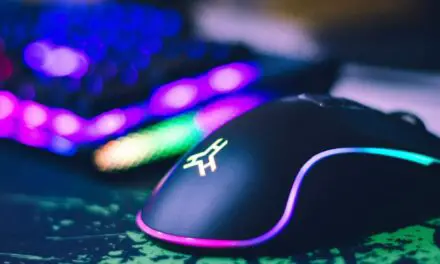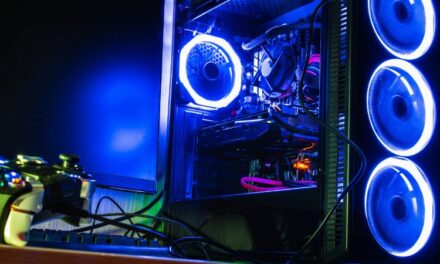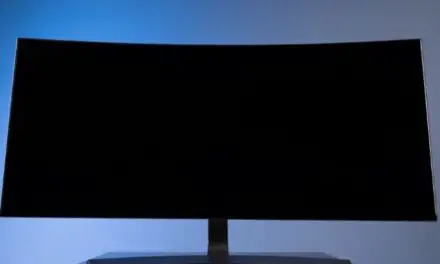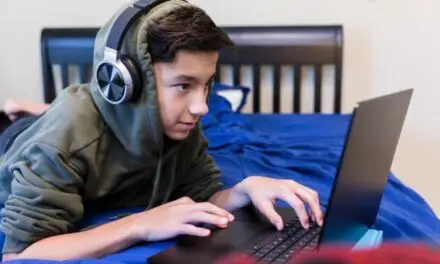A gaming monitor is a display output device, just like any TV, and can be used to play a wide range of media, such as games from Xboxes and other consoles, Blu-Rays and DVDs, streaming content from devices like Chromecasts, TV channels from set-top boxes, video from security cameras or it could even become the display for a laptop you want to game on.
Gaming monitors have all of the input and output ports you would expect in a built-in, PC monitor.
They’re usually a little larger and more portable, however.
And they usually have more ports and connectivity options than regular TVs.
Outside of being connected to a PC, there are loads of uses for gaming monitors.
Once the monitor is getting the right input from a compatible output signal, it should have no problem displaying the content.
A gaming monitor can be connected to a satellite TV box using HDMI or it could just as easily be hooked up to a security camera using video input.
Table of Contents
Can You Use Google On A Gaming Monitor Without A PC?
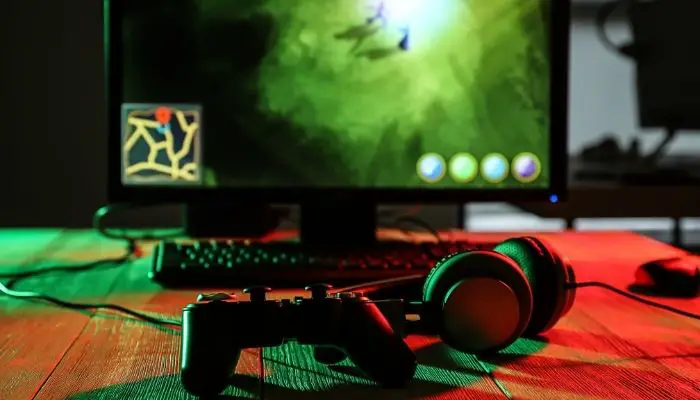
Yes. If you have WiFi you can use Google on a gaming monitor (or regular computer monitor) without a PC by plugging in a streaming device, such as a Chromecast, to download and install a web browser or to mirror your Android smartphone screen to the monitor.
Using A Streaming Device To Use Google On A Monitor Without A PC
If you have a monitor that’s compatible with HDMI you will be able to plug in a Chromecast, an Amazon Fire TV Stick, or Apple TV, which will effectively turn your monitor into a smart monitor and give it the ability to use Google, among many other things.
Once a streaming device has been plugged in, you’ll be able to download a web browser application from the relevant app store and that will allow you to access Google on your monitor and search the web.
Using Screen Mirroring Or Casting To Use Google On A Monitor Without A PC
On many streaming devices, you also have the option to use “screen mirroring” to use your smartphone to mirror Google on your monitor.
If using a Chromecast, you’ll first need to visit the Play Store on your phone and download and install the ‘Google Home’ application.
Once your Chromecast and smartphone are connected to the same Wi-Fi network, open the Google Home app and tap on your Chromecast device.
Finally, select “Screen Mirroring” and this will show everything that’s displaying on your phone’s screen to your monitor.
While viewing apps like YouTube on Android, you’ll also be able to cast your screen from your phone to your monitor without having to go into Google Home.
When on sites like YouTube, lookout for a little rectangle icon that has a Wi-Fi signal inside of it.
Tap this icon to cast your phone’s screen to a monitor that’s on the same Wi-Fi network.
On Apple TV you can mirror your device’s screen wirelessly by tapping the “AirPlay” icon or opening the Control Center and selecting “Screen Mirroring.”
And you can set up a Bluetooth keyboard and mouse if want to use your monitor without having to look at your phone.
However, your smartphone screen will need to stay on as long as you are using screen mirroring.
You Might Also Like: Will Playing Games Damage My Laptop Keyboard? (Explained)
Can You Play Games With Just A Monitor And Keyboard?
Yes, you can use a regular or gaming monitor and keyboard to play games.
However, your monitor will only be able to display the game and has no memory or computing power to run or save it.
The game is going to have to be run from another device like a streaming device, a games console, or accessed through a website.
If you plug a streaming device into your monitor, you will be able to download games from Google Play or the relevant app store and play games using a keyboard.
With a streaming device connected, you will also be able to download a web browser and use it to visit websites that will allow you to play games online, without having to download software.
Newer PlayStations and Xboxes also support play using keyboards and mice so you could connect a console to your monitor and play using a keyboard, which many Fortnite gamers are known to do.
Can You Use A Monitor Without A PC For Xbox and PlayStation?
You can easily play your Xbox or PlayStation by plugging it into your computer monitor using an HDMI cable.
First, plug both your monitor and Xbox or PlayStation consoles in and power them on.
Next, use an HDMI cable and connect one end of the “HDMI TV Out” port on your console and connect the other end to any “HDMI” port on your monitor.
An HDMI cable will make your console and computer monitor plug and play compatible.
That’s about all there is to do.
You can now enjoy playing PlayStation or Xbox games on your monitor.
How To Use Older Gaming Monitors With Game Consoles
A lot of this will depend on the age of the gaming monitor and what you want to hook up to it.
A PS4, for instance, can plug directly into an HDMI port on a gaming monitor.
However, if the gaming monitor is older and has a DVI connection, you’ll need an HDMI to DVI adapter.
If it has a VGA port, you’ll need an HDMI to VGA adapter to plug the PS4 into the monitor.
Both the Xbox Series X and the Sony Playstation 5 support a refresh rate of 120Hz.
That’s pretty standard for gaming monitors nowadays and makes perfect sense for the latest generation of console gaming.
The PS5 and Xbox Series X utilize HDMI and with an adapter or a straight HDMI port for the gaming monitor, that’s all you need to get going.
What’s The Difference Between Gaming Monitors And TVs?
The difference between gaming monitors and regular TVs—even 4k and smart TVs—is that gaming monitors were designed with gaming in mind and have faster refresh rates and lower input lag, while TVs are designed for size and cinematics.
Size
TVs are built to be big and take center stage of living rooms, with numerous people sitting ten feet plus away from the screen and viewing from different angles.
Gaming monitors, on the other hand, are designed for a single person to sit up close and play.
When considering the best size monitor for playing games, the size of 24-inches tends to be the sweet spot because you don’t have to turn your head to take in the whole display.
However, flat screen living room TVs can easily be 75 inches plus.
Response Time
Gaming monitors are made with response time in mind while TVs are not.
Most mid-range gaming monitors will have much faster response times than even high-end TVs with much larger price tags.
For TVs, a bad response time is hardly noticeable when watching movies and regular TV shows.
It only becomes a potential problem when playing games and watching fast-paced sports.
Because of this, TV manufacturers are less concerned with fast response times, which is important for gaming.
Any level of response time between one and ten milliseconds is considered the sweet spot for gamers.
Refresh Rate
The faster a TV or monitor’s refresh rate, the more times the image updates on the screen updates each second, and the smoother movement will look.
The number of image updates each second is measured in hertz (Hz), so a 120Hz refresh rate means that the screen updates 120 times per second.
Having faster refresh rates is more important for gaming than it is for watching TV because it allows your display to keep pace with the rapid movements in-game.
The faster the refresh rate, the smoother and the better the overall viewing quality will be.
Gaming monitors usually have faster refresh rates than TVs.
Input Lag
Typically the amount of time between the input from the keyboard to the result on the screen.
TVs like to process everything, even though consoles and computers do most of that on their own.
Gaming monitors don’t spend any time processing and just relay the image to the screen, creating less input lag.
Despite gaming monitor’s design being tailored for PCs, they are also perfectly suited for use as a TV or a game console.
A game console can take advantage of a gaming monitor’s features, as they have progressed closer to their PC counterparts.
Color Accuracy
Most good gaming monitors support multiple color spaces and are built to display colors accurately and consistently.
This is great if you’re into photography, design, or video editing.
TVs, on the other hand, tend to focus on vibrant, eye-catching colors that may look exciting in an action sequence but do not accurately portray the colors on screen.
Are There Other Uses For A Monitor Without A PC?
There are a lot of uses for PC monitors or gaming monitors if you no longer have a PC for it or recently upgraded and no longer have a use for the older model.
Turn it into a Dashboard
You can easily turn your monitor into a piece of smart, home decor that displays the time, weather, stocks, news headlines, and more.
All you need is a Raspberry 4 Pi—a small, cheap computer—an SD card, and an HDMI cable.
Smart Mirror
Along the same lines as the dashboard, you can also use Raspberry 4 Pi to turn your flat screen monitor into a smart mirror.
Use it as a TV
This is an especially good idea if you like taking in your TV while working in the shop, cooking in the kitchen, or have an overwhelming urge to put a TV in the bathroom.
Picture Frame
Another Raspberry Pi idea.
Create a frame—a good DIY project—and use it as a picture frame with slideshow pictures, similar to the mostly failed Kodak versions but bigger and better.
Fitbit Dakboard
Want to keep all of your fitness tracking and health goals up on the wall to keep track?
Raspberry Pi and the right app combinations will get any DIY project up and running and all you need is the hardware and an old gaming monitor.
The great thing about gaming monitors, or any PC monitor for that matter, is that they aren’t just compatible with a PC.
As it turns out—especially with today’s technology—gaming monitors are customizable as well.
Feel free to unplug your old PC gaming monitor and find one of a hundred different uses for it.
You certainly don’t need a PC for it and game consoles are seemingly tailor-made for gaming monitors.
Or use it for the latest in DIY projects with Raspberry Pi.
Regardless of what you choose to do, there’s no need for a PC to find a use for your old gaming monitor.
